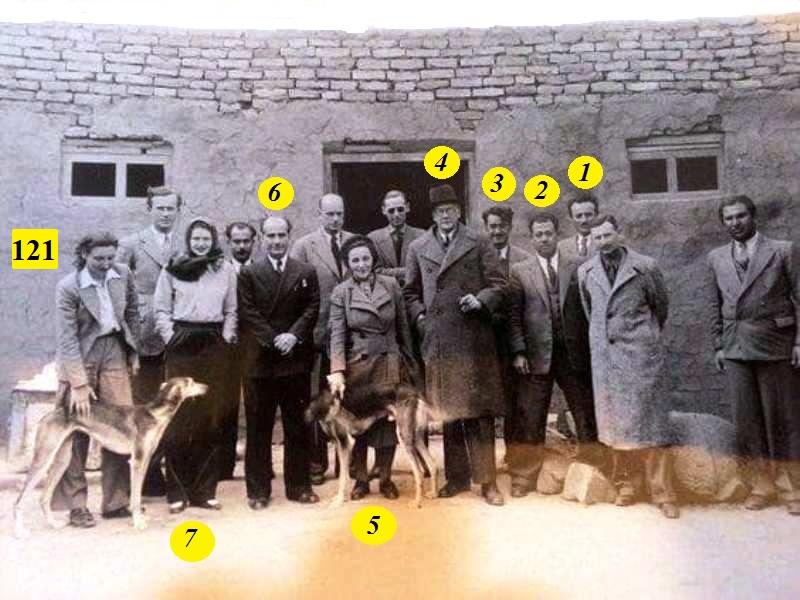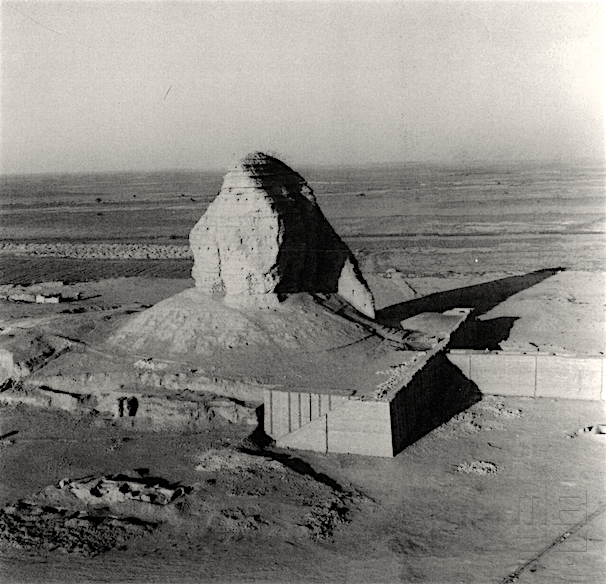Members of the excavation expedition in Kurigalzu for the year 1944 with Mr. Fouad Safar (1), Dr.. Taha Baqir (2), Mr. Muhammad Ali Mustafa (3), Seton Lloyd (4), Ulrike Lloyd (5), Dr. Naji Al-Aseel, Director General of Antiquities (6), Rita Maxwell (7)……..


ziggurat
The Ziggurat of Dur-Kurigalzu, built in the early 14th century BC by Kurigalzu I, is located in the city’s western area and is devoted to the chief Babylonian God Enlil, who Sumerians believed to govern over wind, air, earth, and storm.
In Kassite times the area was defined by a large wall that enclosed about 225 hectares (560 acres). The wall, originally built by Kurigalzu I, was later rebuilt by Kurigalzu II (c. 1332—1308 BC).[14] The site has several defined areas, Mound A (100 meters south of the ziggurat), Tell Ahmar, Tell Abu Shijar, Tell al-Abyad, and a private housing area. The main elements, ziggurat, palaces, etc. are all within the city wall. The currently known structures of the site consist of nine temples (T1 to T9), with T1 being the ziggurat and associated temple to Enlil, three palaces (P1 to T3), and five housing areas (H1 to H5) The site was visited by Bengt Bengtsson Oxenstierna in 1616. Agar Quf first appeared on a modern map by Edward Ives in 1773. The site was then described by Claudius James Rich in 1811.[18] Aqar Quf (referred to then as Akerkuf, Agger Koof, or Akar-kuf) was visited and examined in 1837 by Francis Rawdon Chesney.The name of Dur-Kurigalzu was identified by Henry Rawlinson in the mid-19th century.[20] Door socket from Tell-el-‘Abyad at Aqar-Quf mentioning the name of king Kurigalzu and his palace (E-GAL-KI-SAR-RA), Sulaymaniyah Museum, Iraq Male head from Dur-Kurigalzu, Iraq, reign of Marduk-apla-iddina I. Iraq Museum. Excavations were conducted from 1942 through 1945, by Taha Baqir and Seton Lloyd in a joint excavation by the Iraqi Directorate-General of Antiquities and the British School of Archaeology in Iraq.Over 100 cuneiform tablets of the Kassite period were recovered, now in the Iraq Museum. Some were date-able to the reigns of Burna-Buriash II and Kashtiliash IV. They also showed that two of the palaces were named the Palace of the Mountain Sheep and the Palace of the Stag.[23] A kudurru (IM 49991) dated to year five of Kassite ruler Nazi-Maruttash was also found.[24] During the excavation, 5 fragments of a larger-than-life-size statue were discovered. They contain the longest yet found Kassite Sumerian inscriptions. A baked brick pavement (T5) around two kilometers northwest of Tell al-Abyad was found to be covered with hundreds of broken terracotta figurines dedicated to the god Gula. Bricks found in situ were dated to the reign of Kassite ruler Nazi-Maruttash.[27] The excavations included the ziggurat, three temples, and part of the palace of Dur-Kurigalzu II. 3-D reconstruction of the remains of the main palatial complex in Dur-Kurigalzu. In the early 1960s and from 1968 to 1975 the Iraqi Directorate-General of Antiquities continued to do some excavation around the ziggurat as part of a restoration project under Saddam Hussein The three excavated areas are the mound of Aqar Quf (including the ziggurat and large temple), a public building (approximately 100 metres (330 ft) to the west), and Tell al-Abyad where a large palace was partially uncovered (about 1 kilometre (0.62 mi) to the south-west). Several burned cuneiform tables dated to the reign of Marduk-apla-iddina I were found there.[34] As part of a temple restoration a pottery jar was found containing 220 Islamic silver dirhem coins from the Ilkhanid period.


